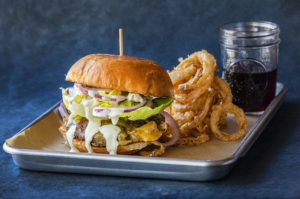 There is an unavoidable tension between the desire to manipulate a carrot into uniform, rectangular shapes (including every culinary knife cut in the parallelepiped family, from the batonnet soldier awaiting its Ranch dressing destiny to the microscopically perfect brunoise at the bottom of a bowl of consomme), and the desire to keep one’s digits unbloodied and persistently attached to one’s hand without surgical assistance. This is, of course, a natural byproduct of the unstable equilibrium created by placing an essentially round object – unless we’re talking seriously pre-fabricated foodstuffs, carrots obviously begin life in the kitchen in approximately cylindrical form – atop the level plane of a cutting board, and subsequently applying extreme pressure over the diminutive surface area of a knife edge.
There is an unavoidable tension between the desire to manipulate a carrot into uniform, rectangular shapes (including every culinary knife cut in the parallelepiped family, from the batonnet soldier awaiting its Ranch dressing destiny to the microscopically perfect brunoise at the bottom of a bowl of consomme), and the desire to keep one’s digits unbloodied and persistently attached to one’s hand without surgical assistance. This is, of course, a natural byproduct of the unstable equilibrium created by placing an essentially round object – unless we’re talking seriously pre-fabricated foodstuffs, carrots obviously begin life in the kitchen in approximately cylindrical form – atop the level plane of a cutting board, and subsequently applying extreme pressure over the diminutive surface area of a knife edge.
Imagine trying to log-roll while wearing hockey skates, or walk a balance beam in Roller Blades, and you’ll have some sense of what you’re asking of your knife skills when you maul a carrot, and an appreciation of why classically trained chefs insist on doing such things one way, and not another. For me, the proper dismembering of a carrot will always be linked inextricably with the classic Lobster Sauce Americaine, because when I was first taught to make this sauce – a truly extraordinary dish, and such an unbelievable, all-day sort of pain in the ass that I’ve been running scared of trying it again for nigh on a decade – I had to cut an allumette of carrots to go with some peas as an accompaniment. While it is certainly true that peas and carrots excel in conjunction with both the lobster meat and the sauce – the flavors meld, the colors pop, and the textural contrast adds interest – I can’t really say why this should be: The minutes it should take to cut some little matchsticks out of a carrot really have very little to do with the final dish, particularly when compared to the hours spent roasting shells, poaching roe, straining the sauce, and all the other jazz that truly define the final product. But food memory can be funny that way, and to this day I cannot cut a carrot without tasting Sauce Americaine; and wondering when I’ll muster the courage to make it again.
In any case, as with most fundamental kitchen tasks, we in the early 21st century have the considerable advantage of several hundred years worth of others’ hard-won experience: The right ratio for a custard or bread dough; the proper way to emulsify a sauce; the proportion of onion in a mirepoix; and how to cut rectangular shapes out of something that is round. The challenge is to keep the round thing from rolling around as you push your knife through it, because if it rolls, then that blade is going to end up somewhere other than in your food, and that usually means you. The solution is equally obvious: Make the round thing not-round by taking off one of its sides. Once this has been accomplished, lie the thing on its newly-flattened side and square off the other three sides, creating a 3D rectangle. From there, you can easily cut flat squares, long planks, thin (julienne) or thick (batonnet) sticks, and any size of cube (dice). Thus does the entire exercise reduce to one cut: You need to get that first side off, in one clean cut, without hurting yourself. (If you’re knife is dull, you will have a real problem – seriously, you need a really good edge to do this safely. But more on the importance of sharp knives in another post.) Decide on the final shape you want (plank, stick, or cube) and the size (fine, medium, large), and everything else is just the consistent replication of a simple pattern:




Cut Your Carrots, Not Your Fingers
There is an unavoidable tension between the desire to manipulate a carrot into uniform, rectangular shapes (including every culinary knife cut in the parallelepiped family, from the batonnet soldier awaiting its Ranch dressing destiny to the microscopically perfect brunoise at the bottom of a bowl of consomme), and the desire to keep one's digits unbloodied and persistently attached to one's hand without surgical assistance.









